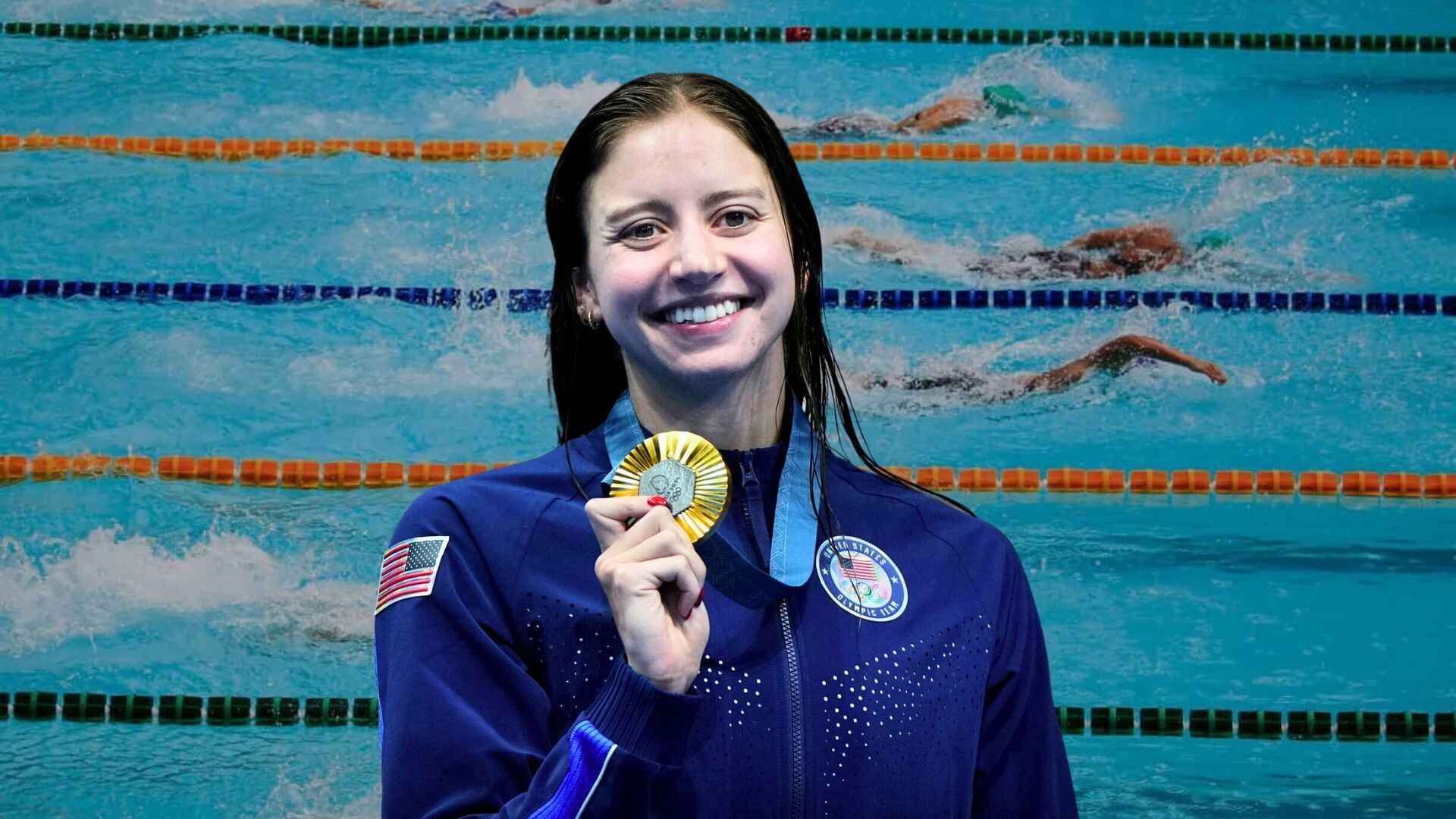Kate Douglass Claims Her First Olympic Gold in the 200m Breaststroke
On August 1, 2024, Kate Douglass achieved a monumental milestone in her swimming career by winning her first Olympic gold medal in the women’s 200-meter breaststroke at the Paris Olympics. Her winning time of 2:19.24 not only earned her a place at the top of the podium but also solidified her status as one of the premier swimmers of her generation. This blog delves into the intricate details of her journey to this historic victory, the dynamics of her performance in the final, and the broader implications of her win for both American swimming and the sport at large.
Early Beginnings and Path to the Olympics
Kate Douglass’s journey to Olympic glory began in her hometown of Pelham, New York, where she started swimming at a young age. Her initial exposure to the sport came through local swim clubs, where she quickly distinguished herself with a natural talent and a strong work ethic. Her parents, recognizing her potential, supported her ambitions, ensuring she had access to the best coaching and training facilities.
Douglass’s rise in competitive swimming was marked by a series of impressive performances at the junior and senior levels. Her dedication to the sport led her to the University of Virginia, where she competed for the UVA Cavaliers. During her collegiate career, she shattered multiple records and won several NCAA titles, showcasing her prowess in the pool and establishing herself as a formidable swimmer.
Her time at UVA was crucial in shaping her career. Under the guidance of experienced coaches, Douglass honed her technique and built the endurance needed to compete at the highest levels. Her training regimen was rigorous, encompassing physical conditioning, technical drills, and mental preparation. This comprehensive approach laid the foundation for her future success on the international stage.
Preparation for the Paris Olympics
As the Paris Olympics approached, Douglass’s focus shifted to preparing for the pinnacle of competitive swimming. Her preparation was meticulous, involving a detailed analysis of her previous performances and a strategic plan to optimize her training. This period was characterized by intense practice sessions, strategic tapering, and a focus on fine-tuning her technique.
Douglass’s training included specific drills to enhance her breaststroke technique, with an emphasis on improving her underwater phases and turns. Her coach worked closely with her to refine her stroke mechanics and develop a race strategy that would maximize her performance in the 200-meter breaststroke.
One of the key elements of her preparation was mental conditioning. Douglass engaged in psychological training to build resilience and focus, essential qualities for competing in high-stakes environments like the Olympics. Visualization techniques and race simulations were integral parts of her mental preparation, helping her to stay composed and confident.
The 200m Breaststroke Final: A Detailed Breakdown
The final of the women’s 200-meter breaststroke at the Paris Olympics was a highly anticipated event, featuring some of the world’s best swimmers. Douglass entered the race as a strong contender, having delivered impressive performances in the preliminary rounds and semifinals. Her winning time of 2:19.24 was a result of a masterful race strategy and flawless execution.
Start and Early Rounds
From the start of the final, Douglass showcased her strength and technique. Her reaction time off the block was swift, and she executed her initial strokes with powerful propulsion. Her underwater kick was particularly effective, allowing her to gain an early advantage over her competitors.
The first 50 meters of the race saw Douglass maintaining a strong pace. Her stroke rate was optimized for speed and efficiency, and her breathing patterns were well-coordinated with her strokes. This early pace was crucial in setting the tone for the remainder of the race.
Middle 100 Meters
In the middle 100 meters, Douglass’s strategy became evident. She maintained a steady rhythm while managing her energy reserves. Her technique remained precise, with smooth, powerful strokes and effective use of her kick. Her ability to sustain this pace while conserving energy was a testament to her training and race strategy.
The turns during this phase were executed with exceptional technique. Douglass’s streamlined position off the walls and her efficient push-offs allowed her to maintain speed and minimize drag. Her turns were crucial in maintaining her lead and setting up for a strong finish.
Final 50 Meters
As the race entered the final 50 meters, Douglass made a decisive move. Her acceleration in the closing stages was a key factor in her victory. Her powerful strokes and effective breathing allowed her to surge ahead of her competitors. The final stretch of the race was marked by Douglass’s impressive sprinting ability and endurance.
Her final time of 2:19.24 was a culmination of her precise technique, strategic pacing, and physical conditioning. This time not only secured her the gold medal but also highlighted her dominance in the 200-meter breaststroke. The margin of victory underscored her exceptional performance and the meticulous preparation that led to this achievement.
Reactions and Celebrations
The reaction to Douglass’s victory was overwhelmingly positive. Fans, fellow athletes, and media outlets celebrated her achievement, recognizing the significance of her gold medal. Her performance was widely praised for its excellence and strategic execution.
The celebrations following her win brimmed with emotion and joy. Douglass’s family and friends, who had supported her throughout her career, felt elated by her success.
Douglass’s victory also garnered attention from the broader swimming community. Her achievement was celebrated as a significant milestone in American swimming, adding to the tradition of excellence in the sport. Her success served as an inspiration to aspiring swimmers, demonstrating the rewards of perseverance and skill.
Analysis of the Performance
Several key factors characterized Douglass’s performance in the 200-meter breaststroke final and contributed to her success. Her time of 2:19.24 reflected a combination of technical precision, strategic planning, and physical conditioning.
Technical Mastery
Douglass executed her breaststroke technique with exceptional precision. She optimized her stroke mechanics—hand entry, pull, and recovery—for speed and efficiency. She applied powerful propulsion to her underwater kick, a crucial aspect of the breaststroke, which allowed her to maintain speed throughout the race.
Her turns were another highlight of her performance. Douglass’s streamlined position off the walls and her efficient push-offs minimized drag and allowed her to maintain momentum. This technical mastery was a key factor in her ability to execute a strong race strategy.
Strategic Execution
Douglass’s race strategy was characterized by effective pacing and energy management. Her ability to maintain a steady pace in the middle 100 meters while conserving energy for a strong finish was a testament to her strategic planning. Her final sprint demonstrated her endurance and ability to accelerate when it mattered most.
The mental conditioning complemented the strategic aspect of her race. Douglass’s ability to stay focused and composed under the pressure of an Olympic final was a crucial element of her success. Her mental preparation allowed her to execute her plan effectively and perform at her best.
The Impact on American Swimming
Douglass’s gold medal win has significant implications for American swimming. Her achievement adds to the rich tradition of excellence in the sport and serves as an inspiration to future swimmers. The success highlights the strength of American swimming programs and the potential of young athletes to achieve greatness on the global stage.
This victory also underscores the importance of continued support for athletes and investment in training and development programs. Douglass’s story is a reminder of the rewards that come from dedication and hard work, and it provides a model for future generations of swimmers.
Looking Ahead
As Kate Douglass looks to the future, her recent gold medal victory sets a strong foundation for her career. Her success at the Paris Olympics positions her as a leading figure in the sport, and the coming years will likely see her continue to build on her achievements.
Douglass’s future endeavors may include further competitive successes, as well as potential involvement in other aspects of the sport. Her achievements could inspire her to contribute to swimming through coaching, mentoring, or other roles that support the development of future swimmers.
Conclusion
Kate Douglass’s gold medal in the 200-meter breaststroke at the 2024 Paris Olympics represents a landmark achievement in the world of swimming. Her winning time of 2:19.24 reflects her exceptional skill, preparation, and determination. Douglass’s performance is a testament to her dedication and hard work, and her victory highlights the excellence of American swimming.
Her success will resonate for years to come, influencing the sport and inspiring future athletes to pursue their Olympic dreams. As the swimming world reflects on this remarkable achievement, Kate Douglass’s gold medal stands as a beacon of excellence and hope for aspiring swimmers everywhere. Her story of perseverance, skill, and triumph will continue to inspire and motivate swimmers around the globe.




